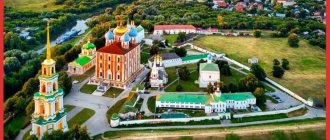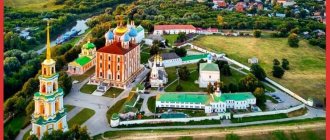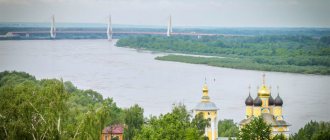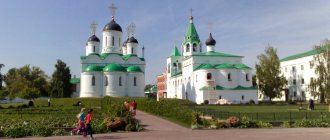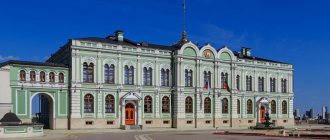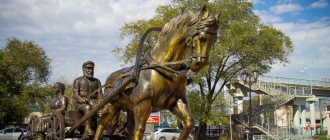NOVOKUZNETSK , a city of regional subordination of the Kemerovo region, the center of the district of the same name; located in the Kuznetsk Basin, on the Tom River, at the confluence of the Aba and Kondoma rivers, 308 km south of Kemerovo. Junction of railway lines and roads. Airport.
From 1618 - Kuznetsk fort, from 1622 - the district city of Kuznetsk or Kuznetsk-Sibirsky, from 1804 - the center of the Kuznetsk district (1822-97 - district) of the Tomsk province, from 1924 - a regional center, in 1932 merged with Garden City into the city of Novokuznetsk, in the same year it was given the name Stalinsk, from 1939 - the regional center of the Novosibirsk region, from 1943 - the Kemerovo region, from 1961 - renamed Novokuznetsk.
General information
Russia, Kemerovo region, Novokuznetsk - the exact address of the location of the settlement. The unofficial name is the Southern capital of Kuzbass.
The historical map of the city (Novokuznetsk) notifies that this city in the Kemerovo region is the thirteenth largest city in the country. The population is more than five hundred and fifty thousand people. Among settlements that are not constituent entities of the Federation, it ranks second.
The density is about one thousand three hundred people per square kilometer.
The city of Novokuznetsk, Kemerovo region is the center of the Kuzbass agglomeration. The total population living near the settlement is almost one and a half million people.
The center of industry is the city of Novokuznetsk. The region in which the settlement is located is Kemerovo, bordering the Tomsk and Novosibirsk regions. Also nearby is the border with the Krasnoyarsk, Altai Territories and the Republic of Khakassia.
A major center of coal mining is the city of Novokuznetsk. Large coal basin area.
Postal codes - from 654000 to 654103.
Telephone code – 3843. Six-digit numbering of the city network.
Vehicle codes are 42 and 142.
City Day is celebrated on the first Sunday in July.
It is on the list of the best thirty cities in the Russian Federation for doing business.
There are branches of more than forty banks in the city.
The main population is young people aged 20-45 years.
Interesting Facts
Geographical data
The city of Novokuznetsk - Kemerovo region. The settlement is located in the south of Western Siberia.
Novokuznetsk on the map of Russia is located on the banks of the Tom River. Geographical location - south of the Kemerovo region.
Novokuznetsk on the map of Russia is located in the time zone of the Krasnoyarsk Territory, which is the seventh according to Greenwich Mean Time. Relative to the capital of the Russian Federation - plus four hours.
The distance to Moscow is just under four thousand kilometers by road. To get to the regional center, the city of Kemerovo, you will have to cover a little more than two hundred and twenty km.
The city map (Novokuznetsk) indicates that the settlement is divided into six districts. The area is just over four hundred twenty-four square kilometers. The altitude above sea level is one hundred and ninety meters.
The climate is sharply continental and dry. Significant annual temperature fluctuations. The average annual value is approximately two degrees Celsius.
The minimum value is minus fifty-two, the maximum is thirty-eight.
The number of sunny days is about two hundred and eighty.
The average precipitation is six hundred millimeters. Soil freezing is up to two meters. The average wind speed is two and a half meters per second.
Class hour "History of the emergence of the city of Novokuznetsk"
History of the emergence of the city of Novokuznetsk
Developed by: Kuzovkova T. A.
"Be proud of the glory of your ancestors
Not only is it possible, but it must be.”
A.S. Pushkin.
Hundreds of thousands of years ago, Siberia had a warm climate. The vast expanses were covered with lush, heat-loving vegetation. On the site of the modern Siberian taiga, deciduous trees then dominated: oak, beech, maple, linden, ash and even walnut. A living green monument to long-extinct pre-glacial vegetation in Kuzbass is the “linden island” of 10 thousand hectares, located in the south of our region, near the village of Kuzedeevo.
In those distant times, the fauna of the Kuznetsk land was also different. Mammoths and rhinoceroses, bison and red deer lived here, herds of wild horses and other animals grazed.
The rich fauna of the Kuznetsk Basin attracted people living in Altai and Kazakhstan. In pursuit of animals, they moved further and further north. Thus, the first people who appeared on the territory of our region were hunters. They came here during the Old Stone Age - about 30 thousand years ago. The life of people in our region in the Old Stone Age is evidenced by the tools that were found by archaeologists in the area of the old Kuznetsk fortress.
Millennia passed. The climate of Siberia was changing, the old fauna was dying out, and the vegetation was changing. People learned to grind stone, use bows and arrows, and make pottery. It was already the New Stone Age. The life of people in our region at this time (Neolithic) is evidenced by numerous finds of the Kuznetsk Neolithic burial ground.
People of the New Stone Age already knew how to make fire, make warm fur clothes, and build dwellings. This allowed them to live in harsher natural conditions. Their main occupation was hunting, fishing and gathering. Fish were caught using bone harpoons and hooks. Hunting still occupied an important place, providing the main food product.
In the ll-l millennia BC. e. Significant changes took place in the life of the tribes inhabiting the Kuznetsk Basin: copper and later bronze tools appeared. Among the tribes, hunting and gathering give way to cattle breeding and agriculture.
In the middle of the 1st millennium AD. e. the tribes that lived in the Kuznetsk Basin begin to switch to iron. The production of iron tools developed very quickly and created conditions for the further development of agriculture and crafts.
Numerous finds of the late Iron Age indicate that Turkic nomads lived on the territory of the Kuznetsk Basin in the 8th-10th centuries. They lived here until the 16th century. Their descendants are modern Teleuts. In addition to the nomadic Turks in the river basin. Condoms have long been inhabited by a large clan of “Shor”. After his name, Shors began to be called all the indigenous inhabitants of the Kuznetsk land.
The small and scattered tribes of our region did not create their own state and often became dependent on nomads. At the beginning of the 15th century, the Kuznetsk land became dependent on the Oirot khans, who subsequently created a strong state.
At the beginning of the 17th century, Russian explorers penetrated into the valley of the Tom River. Ermak's campaign marked the beginning of the annexation of Siberia to the Russian state. In 1604, the Cossack head G. Pisemsky and the boyar's son V. Tyrkov built the Tomsk fort on the lands of the Tatar prince Tayan, who voluntarily joined Russia. It became the center from which the development of a huge region began, known to Russians for a long time under the name of Kuznetsk land.
The ancestors of modern Shors were skilled craftsmen in smelting iron from ore and manufacturing various iron products. Siberian chronicles also called the population of the upper reaches of the Tom, Mrassu and Kondoma “blacksmiths”. This is where the names Kuzneyky fort, the city of Kuznetsk, and Kuznetsk land came from.
Its favorable geographical position turned Kuznetsk into a center for the development of a huge region. Tomsk Cossacks Ivashko Volodymerets “and his comrades” reported in 1622 about the enormous wealth of the Kuznetsk land and the occupations of the indigenous population:
“The Kuznetsk fort stands on the Tom River. Near the Kuznetsk fort on Kondoba (Kondom) and Bras (Mrassu) there are great stone mountains, and in those mountains the Kuznetsk people eat stone, and then they light the stone on wood and break it finely with hammers, and after breaking it they sow sieves, and after sifting, they pour little by little into the forges , and in that iron is fused, and in that iron they make armor and bekhterets, shells, spears, spears and sabers and all kinds of iron. And there are three thousand Kuznetsk people in the Kuznetsk land, and all those Kuznetsk people are capable of doing all kinds of blacksmith work... And they live in the mountains. And every forest grows on the mountains, and that forest is cleared, arable land is plowed, wheat, barley, and hemp are sown..."
Thanks to the annexation of our region to the Russian state, the indigenous population began to draw closer to the more advanced Russian people in terms of economy and culture.
Russian people taught him to make hay for livestock using a scythe, to use firearms in hunting, and taught him carpentry. Local residents, looking at the Russians, “leave their smoky villages (yurts) and build huts, began to keep chickens, geese, and got sheep.
Thanks to the Russians, the first literate people appeared among the indigenous population.
A Russian woman made a great contribution to improving the life of the indigenous population of our region. It was she who taught local residents how to cut and sew Russian-style clothes, bake bread, wash floors, whitewash walls, and sleep on beds.
Kuznetsk received city status in 1622. Its population was small, but in 1642-1682, after uprisings, Moscow archers were exiled to Kuznetsk and the population of Kuznetsk began to swell with the help of “sovereign disobedients.” By the beginning of the 18th century, there were 290 households in the city and about 1,500 people lived.
By order of Tsar Peter I, ore was found in Siberia, the development of the mining industry and the construction of factories began. Local tribes constantly raided the enterprises being built here, set fire to buildings, killed settlers, and in every possible way interfered with exploration work. To protect the territory, a guard line of fortresses and defensive cities was created, which included Kuznetsk. Its new fortifications are made of stone. Kuznetsk became the first full-time stone fortress among Siberian cities, received a “regular” layout, a garrison, a “Cossack” outpost outside the fortress walls and a signal beacon on Mayakovaya Mountain. From the city, a line of 15 outposts and redoubts stretched along the banks of the Kondoma further to Biysk. And at that time Kuznetsk was subordinate to two departments - the Tobolsk provincial office and the mining authorities.
Since 1804, according to the administrative division, Kuznetsk was classified as a district town and became the center of the Kuznetsk district of the Tomsk province. A little later, the city received a coat of arms, in the upper part of which there was the emblem of the provincial coat of arms - a running horse, and in the lower part, on a golden field - an image of a blacksmith with a forge, an anvil and a hammer. By the middle of the 19th century, Kuznetsk was losing its defensive significance, and in 1846 its fortress was abolished. Remote from the main trade routes, Kuznetsk could not develop as a trade center in Siberia. The administrative role of the city was determined by its central location in the district. The basis of economic life was agriculture and fur trading. The city itself looked like an agricultural settlement, whose inhabitants were engaged in agriculture, cattle breeding, beekeeping and worked in gold mines.
Old Kuznetsk
On the territory of Kuznetsk there were several churches, such as the Transfiguration Cathedral, the Church of Hodegetria, in which F.I. was married. Dostoevsky in 1857 with Maria Isaeva.
Despite the enormous mineral wealth, industry in Kuznetsk never received proper development. At the beginning of the 20th century, it remained a provincial town, provincial even by Siberian standards.
City of the early 20th century
New history of Novokuznetsk
The new legendary history of the city began with the construction of the railway in 1914. to Kuznetsk and from the decision to build the Kuznetsk (then Telbes) metallurgical plant by the Russian government in 1927.
Modern Novokuznetsk was formed on July 3, 1931 by the decision of the Presidium of the Central Executive Committee of the USSR from the village of Sad-Gorod (since 1929) at the metallurgical plant under construction. Renamed in May 1932 to Stalinsk, before that in March 1932. "swallowed" Kuznetsk.
Stalin's industrialization of the USSR in the 1930s turned the city into a coal mining and industrial center.
The famous poem by V.V. is dedicated to Novokuznetsk. Mayakovsky “The Story of Comrade Khrenov” (“I know that there will be a city, I know that the garden will bloom when there are such people in the Soviet country”). In 1929 According to the American project, under the leadership of chief engineer I.P. Bardin, construction began on the Kuznetsk Metallurgical Plant, launched in 1931.
Pitted with pits and dotted with access railway tracks, the construction site of the Kuznetsk Metallurgical Plant gradually took on the shape of a large industrial enterprise with main workshops and auxiliary production units.
At the same time, the city was being built with the first stone residential buildings according to the master plan created by the outstanding German architect and urban planner Ernst May.
Over the following years, the city acquired its unique appearance, a unique character, expressed in straight, bright streets, memorable squares and architectural ensembles. The best architects of the country implemented their wonderful ideas here.
Inscribed in golden letters in the history of Novokuznetsk are lines telling about the exploits of Novokuznetsk residents during the Great Patriotic War.
64 thousand city residents went to the front, more than 14 thousand of them died. 52 residents of Novokuznetsk were awarded the high title of Hero of the Soviet Union.
The contribution of the Kuznetsk home front workers is invaluable to the overall treasury of the great victory. In 1941 The evacuated Novokuznetsk Aluminum Plant and the Kuznetsk Ferroalloy Plant were re-opened; the Kuznetsk Metallurgical Plant produced military products. Kuznetsk metallurgists quickly mastered the technology for producing armor steel and rolling it. Tank armor, aluminum, rails, coal, and coke flowed in a continuous stream to various enterprises in the country, where a stubborn labor battle with the enemy was also going on.
The post-war years of Novokuznetsk are marked in history as the years of the highest growth, the construction of enterprises, the development of new coal mines and open-pit mines, the construction of cultural, educational, and healthcare facilities.
Our region is a huge construction site. It's all in the woods of new buildings. Coal preparation factories, coke batteries and blast furnaces, residential buildings and schools, theaters and shops are being built.
In 1961 In record time, one of the largest in the world, the West Siberian Metallurgical Plant, was built, which is still the guarantor of the well-being of Novokuznesk residents.
Zapsib is not that kind of romance at all,
Where are the sails, where are the lute strings.
Only fanatics remained here -
Romantics of harsh everyday life.
February 4, 1971 the city was awarded the Order of the Red Banner of Labor on July 1, 1981. - Order of the October Revolution.
The crisis that struck Soviet society at the turn of the 80s and 90s of the 20th century dealt a significant blow to the city’s economy. Since the second half of the 80s, a steady
decline in economic growth rates. In the context of transition to a market economy
a significant number of enterprises went bankrupt and simply stopped operating
existence.
However, despite the difficult economic situation in recent years (a crisis that has affected most countries), the city has retained not only its industrial potential, but also its workforce. Novokuznetsk is still a powerful industrial center of Siberia today. The city has more than 1,200 industrial enterprises, of which about 50 are leading in their industries.
Novokuznetsk is a city of regional subordination (Novokuznetsk city district), the administrative center of the Novokuznetsk district of the Kemerovo region, the largest, after Togliatti, of the Russian cities that are not a regional center and one of eight regional cities that surpass its regional center (Kemerovo) both in population, and in terms of industrial potential.
Novokuznetsk is one of the largest metallurgical and coal mining centers in Russia. Novokuznetsk is an embodiment, a materialized connection of times. Our ancestors lived here, we live here and our descendants will live here.
…Our city is many years old,
He experienced a lot of grief and troubles,
But despite all this, he lived,
How much patience and strength there was!…
Story
The settlement was founded in 1618 as the Kuznetsk fort. In 1622 it received city status.
At the beginning of the eighteenth century, gold was discovered in these areas, which contributed to strong economic growth. Unfortunately, it didn't last long.
The modern city begins its countdown on the third of July 1931 by uniting the cities of Kuznetsk and Novokuznetsk. The city owes its appearance to the construction plant, which was just under construction at that time.
In 1929 the first stone of the metallurgical giant was laid. In 1931 he began his work.
During the war, he carried out important orders for the production of combat vehicles, tanks, and shells.
The settlement was initially destined for the role of an important coal mining and industrial center. Novokuznetsk was even glorified in the work of Vladimir Mayakovsky, “Khrenov’s Story about Kuznetskstroy and the People of Kuznetsk.”
In 1932 the city was renamed Stalinsk. In 1961 it again received its original name - Novokuznetsk.
Culture
Novokuznetsk is characterized by comprehensive development. The city is famous for its large number of museums and interesting architectural structures, although before the revolution there were only a few stone buildings in the village. Mass development of Novokuznetsk began in 1929. A city development plan was created, and new areas appeared.
Today there are four theaters in the city. You can hear a lot of good reviews about the drama theater. This is the most important cultural center of the city. Construction of the theater began in 1932. In just 200 days, it was possible to erect a building with 1,200 seats. Today, modern plays with famous actors are staged here.
The city also has a cinema, which dates back to Soviet times. It has a corresponding name - “October”. Four cinema halls broadcast modern films and cartoons almost around the clock.
Industry
One of the oldest cities in Siberia is Novokuznetsk. What area of industry is developed here!
The basis of the potential is the production of finished metal products, mining, production and distribution of electricity. The largest enterprises are the West Siberian Metallurgical Plant (ZSMK), the Novokuznetsk Metallurgical Plant (NKMK), aluminum and ferroalloy plants. Rail rental has been developed.
Coal industry: large mines and large coal mining companies.
Mechanical engineering: production of mining equipment, sanitary products, etc.
Powerful construction companies, including KuzbassTransStroy, Kuznetskpromstroy, Kuzbassshakhtostroymontazh.
There is also a timber industry, a food industry - a distillery, a confectionery factory, a food processing plant, and a dairy company. The production of baby food has been established.
Chemical, pharmaceutical, medical and light industries are also developed.
Powerful electricity producer – Novokuznetsk. What region can boast such a powerful tandem of enterprises?
Kuznetskaya CHPP is a coal-fired thermal power plant. The generated power is one hundred and eight megawatts of energy.
In addition, there is the Central Thermal Power Plant, the Novokuznetsk Gas Thermal Power Plant, and the West Siberian Thermal Power Plant.
Additionally, in addition to its own electricity generation to supply adjacent mines and settlements, the population is supplied with hot water.
In total, there are about forty enterprises in the city.
Due to the presence of powerful production, the environmental situation leaves much to be desired. Local waters have high levels of iron, magnesium, copper, and petroleum products.
Railway transport
Of course, the population is not in the city (Novokuznetsk) all the time. What region and region is not connected with this wonderful settlement!
Novokuznetsk is a large railway junction. From the central station you can get to almost every corner of the Russian Federation. The most popular are trains to Moscow, St. Petersburg, Novosibirsk, Vladivostok, Tomsk, Barnaul, Adler, Anapa.
Communication within the region has been developed.
International connections – Kazakhstan and Kyrgyzstan.
Population gain or loss according to the census
The total and official population of the city of Novokuznetsk, how many people live in it as of January 1, 2022, the number of people in each individual city district and municipality, further in the second table.
| Year | Growth/decrease population city of Novokuznetsk |
| 2017 | ↗552,445 people |
| 2018 | ↗553,638 people |
| 2019 | ↘552 105 people |
| 2020 | ↘549 103 people |
| 2021 | ↘544,583 people |
| 2022 |
Attractions
Novokuznetsk is famous for its culture. Which region can boast a fortress-museum and a house in which Fyodor Mikhailovich Dostoevsky himself lived for some time?
Novokuznetsk can. In addition, there is a palace of culture and technology, busts and monuments to outstanding people and objects - Alexander Vasilyevich Suvorov, Vladimir Lenin, Yuri Gagarin, Sergei Kirov, Georgy Konstantinovich Zhukov, Maxim Gorky, Lev Nikolaevich Tolstoy, the Russian penny. It is also worth visiting cinemas, drama and puppet theaters, several obelisks, cathedrals and temples, a chapel, a local history museum, a wine warehouse, libraries, a circus, shopping and entertainment complexes, and markets.
In addition, you can while away the time in the planetarium, city parks of culture and recreation, public gardens, landscape monuments, visit a waterfall or the largest bowling club in Siberia.
The historical center will delight you with ensembles from the eighteenth and nineteenth centuries. Several old buildings have been preserved.
The famous fortress was built by order of Paul the First at the beginning of the nineteenth century.



